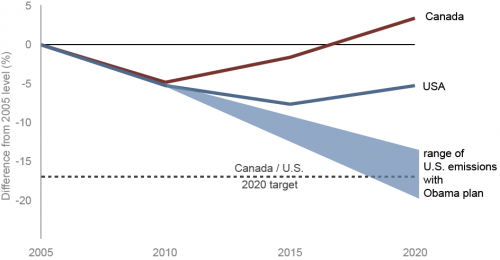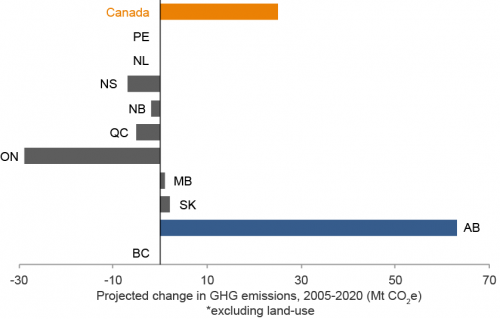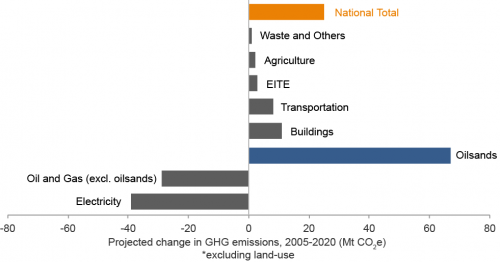Last week, Environment Canada released its annual Emissions Trends report, projecting the path of Canada’s climate-warming greenhouse gas emissions. This blog looks at what the report says and why it matters.
What is Emissions Trends and why is it important?
Canada’s Emissions Trends is an indispensable report from Environment Canada and a welcome example of government transparency. Carefully put together by a top-notch team of analysts, the report lays out Environment Canada’s best guess about the future path of Canada’s greenhouse gas emissions under current policy. It tells us where our emissions are headed in each sector and in each province, as well as nationally, and allows us to compare this to a hypothetical scenario in which no action was taken.
Credible, timely and publicly accessible emissions projections like this are essential to creating a shared basis for constructive policy discussions about energy and greenhouse gas emissions in Canada. Working from a common set of facts helps focus debates on the important stuff, like our country’s energy future, rather than on whose numbers are more credible.
Projections like this allow analysts to compare expected performance against the commitments Canada has made. The Harper government has promised to reduce the harmful emissions that are driving climate change — and if this is not happening we need to understand why.
What are the key findings of this year’s report?
The main message is very clear: Canada’s emissions are headed in the wrong direction. They are headed up, not down, and by the end of this decade are projected to be 20 per cent higher than the level to which Canada has committed. Last year’s report also warned of this yawning gap — a gap much bigger than the emissions from every power plant in the country, put together.
And this year’s edition shows that Ottawa has done nothing over the past year to change this trajectory: there is not a single new policy on the list of federal initiatives to reduce emissions in Canada. So it's little surprise that the country is no closer to reaching its emissions target. In fact, the gap between where we are headed and where we should be headed has grown slightly in the past year.
The central conclusion of this year’s report is inescapable: without a serious ramp up of effort from our government, Canada is headed for another major broken promise on climate change. This is bad news for a lot of reasons, not least for our credibility.
We share the same emissions reduction commitment as the United States. Thanks to the climate policies President Obama has put in place, and the additional ones he has committed to adopting, U.S. government projections can now assert that they are on track to meet their target. We cannot. Each day that Canada lacks a credible plan to meet our commitments, our claims to climate leadership and responsible resource development ring increasingly hollow.
Projected GHG emissions for Canada and the United States
What can we do?
When jurisdictions take strong action to curtail emissions they get results.
The best example arguably comes from Ontario. Between 2005 and 2020, emissions from electricity in Canada are projected to fall by 39 million tonnes, the biggest decrease in any of Canada’s sectors. A lot of the credit for that decrease in emissions is due to provincial action like Ontario’s coal phase-out, which the province accompanied with support for clean energy and conservation.
Provinces like B.C., Ontario, Quebec and Nova Scotia are mustering significant effort to cut emissions and have seen their per-capita pollution fall. The emissions curve is also bending down in the transportation sector, where federal efficiency standards are expected to improve the fuel economy of new cars and trucks.
Projected change in GHG emissions by province, 2005-2020
So policies previously put in place by governments at both the provincial and federal level are making an impact. Emissions Trends estimates that Canada’s emissions are 128 Mt lower now than they would be if the provinces and Ottawa hadn’t taken any action to date. That’s nothing to sneeze at.
But it’s also just a start. Despite these past actions, Canada’s emissions are still projected to increase over the remainder of this decade. Closing the gap to Canada’s 2020 target is still going to be a huge job, one that will require far stronger action from Ottawa and the provinces than we’ve seen to date, particularly over the last year.
Sectors that have not yet been regulated need to be addressed quickly. The oil and gas sector — a rapidly growing emissions source that accounts for nearly a quarter of Canada’s carbon pollution — still has no federal greenhouse gas constraints of any kind. Without new rules, oilsands emissions are projected to triple between 2005 and 2020, in the process wiping out all the reductions that all other sectors in the country are projected to make. By the end of the decade, oilsands emissions are expected to emit more greenhouse gas pollution than any province, save Ontario and Alberta.
This rapid and uncontrolled growth in future oilsands emissions is the biggest barrier to getting Canada’s emissions on a downward track.
Projected change in GHG emissions by sector, 2005-2020
Unfortunately, the federal government is currently not considering an economy-wide price on carbon, which would be a huge boost to climate action across Canada and a valuable complement to the rules they have enacted. But there’s no reason at all why they couldn’t be doing much more to develop strong sectoral regulations, reinvesting in smart programs to boost clean energy and energy efficiency, and working with provinces and municipalities on important priorities for sustainable transportation.
This year’s Emissions Trends paints a disappointing picture. But Canada’s government has the power to change it with ambitious and effective policy.











